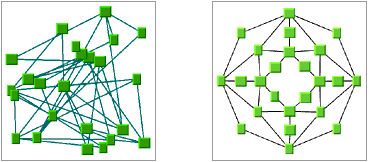Graph layout
NOTE Graph layout features are only available if you have purchased a full JViews Diagrammer license.
In some situations, diagrams can be drawn manually and still kept clear to read. The user typically places the nodes and links and repositions the nodes manually if the diagram becomes cluttered.
In many cases, the diagram is too complex to be handled manually, or there is no human being involved: the diagram is built dynamically with application data that does not contain any geometric information. In such cases,
automatic layout algorithms are required to position the nodes and to route the links.
The Graph Layout package is a set of
layout algorithms provided with JViews Diagrammer to position nodes and labels, and to route links, automatically. The goal of a layout algorithm is to propose solutions in which nodes do not overlap, links do not cross nodes or links, and labels do not overlap other objects. Ideal solutions do not always exist, but an algorithm will tend to an optimal one, see the following figure.
Applying a graph layout: before and after
The most effective way of displaying a graph depends on its type and sometimes on industry standards. JViews Diagrammer offers various algorithms with many parameters to adapt to the many situations. For example, the hierarchical layout is mainly used for displaying flows and processes; circular and bus layouts for LAN networks; radial tree layout for semantic networks and website maps; and tree layout for organization charts, decision trees, and directories.
In JViews Diagrammer, several graph layouts can be applied to a single diagram: a subgraph may require a different layout to its parent; or one layout can be applied to only a subset of the nodes. Constraints can also be set, for example, to make nodes with a certain
property stay above the others.
When it comes to routing links, JViews Diagrammer offers strategies to limit the length of links, algorithms to bundle links or connect nicely to nodes—especially when several links arrive at a single node.
The label layout (labeling) algorithm makes sure that labels do not overlap—which would make them hard to read—by shifting them slightly away from their base position and by rotating them if necessary. This algorithm is used for labels on nodes and links, and for labels in Rogue Wave® JViews Maps.
Copyright © 2018, Rogue Wave Software, Inc. All Rights Reserved.
